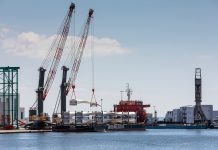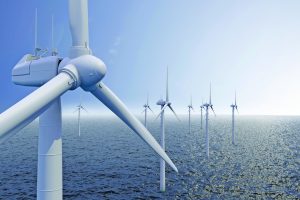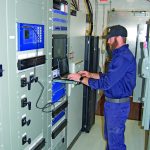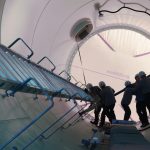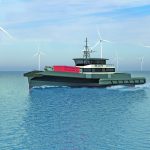Odds are that most people—with the possible exceptions of engineers, academics, and the occasional “Jeopardy!” contestant—can’t quote the formula for gravitational potential energy. As far as physics is concerned, gravitational potential energy is calculated by multiplying an object’s mass by the gravitational field strength by the height of the object.
In Pampa, Texas, however, it’s about metaphysics instead of physics. The potential has always been there, and now, the wind power industry is gravitating to the Texas Panhandle to harness that potential.
Since its inception in 2006, the Pampa Economic Development Corporation—which seeks to foster economic growth for its home community by actively promoting, facilitating, and incentivizing industrial, commercial, and agricultural investment in the region—has been an important catalyst in that chain of events.
“The organization is a Type B economic development corporation with sales tax authorized pursuant to the Development Corporation Act,” said executive director Clay Rice. “As a Type B economic development corporation, we are allowed to help fund not only business and industrial projects but community development projects as well.”
Located a little less than an hour’s drive from Amarillo, northeast along U.S. Highway 60, Pampa, Texas, is home to 18,000 people, Clarendon College’s Pampa Center, and some of the best wind resources in the nation.
Currently, the local economy chiefly consists of manufacturing, oil and gas interests, agriculture, medicine, and retail. However, the wind energy industry—rapidly expanding in the region—may soon join that list.
“Things are certainly moving in the right direction even though we are in the very early stages of the wind energy industry in the Pampa, Gray County area,” Rice said. “The industry is certainly taking off.”
That fact is evidenced by current activity on several projects in the region.
“Three wind farms are now under construction, or soon will be in adjoining counties. They will move into our county (Gray) at some point in the future. In addition, there is a potential 500 MW wind farm planned that will be located completely in Gray County.”
The potential for wind energy in the Pampa region has been closely studied and well known for quite some time. Drawing not only on its Class 4+ wind resources, but also wind farm and manufacturing site availability, highway and rail transportation, the Pampa Energy Center, and new transmission/grid infrastructure projects, the region has proven itself to be highly favorable for wind energy development, as well as other industries.
Pampa first appeared on the wind energy scene in 2007, when oil magnate T. Boone Pickens formed a wind energy development company called Mesa Power with the intent to build the world’s largest wind farm project—envisioned at 4 GW—in the Pampa region.
In May of 2008, Pickens placed an initial turbine order totaling 1 GW with General Electric for the first phase of the Pampa project. Pickens was quoted as saying: “We are making Pampa the wind capital of the world.”
Unfortunately for the region, Pickens would end up postponing, and later canceling the project, initially citing the lack of transmission lines, and ultimately the favorable economics of natural gas, as factors in his decision.
Now, with the transmission infrastructure in place, the wind industry is thriving in Pampa.
“In order for renewable energy to be moved from our area where wind resources are excellent to heavily populated areas of the state where wind is not as plentiful, new transmission facilities had to be developed in the Panhandle,” Rice said. “Through a project called CREZ (Competitive Renewable Energy Zones), the Public Utility Commission of Texas selected transmission service providers to construct, operate and maintain the transmission improvements. The completion of this project has made current and future wind farm development in the Panhandle possible. Without it few wind farms would be developed but with it we are likely to see thousands of wind turbines dotting our region in the next few years. Thanks to the CREZ project, in Gray County we now have new transmission lines and a new substation (Gray Substation).”
Economic studies performed by consultants hired by Mesa in the planning stages of the initial 4 GW project estimated its overall economic output at $380 million annually while the wind farms were being built. The studies suggested that number could jump to $1.6 billion per year once the project reached commercial operation. Workforce impact estimates forecast as many as 1,500 temporary (during construction) and 720 permanent jobs resulting from the Mesa project.
That amount of economic impact may still be possible with the combined efforts of multiple commercial interests and a favorable political climate for wind energy. Regional public sentiment and stakeholder support for wind development (which was reported to have been an obstacle for the Mesa project) appears to be quite positive.
“Overall there is great excitement about the development of the wind energy industry here. You can drive west on U.S. Hwy 60 and see wind turbines under construction,” Rice said. ”There are some people with concerns but they come up only occasionally. I do not think that there is much anxiety about it. Our economy is strong now and I think as people see it getting stronger and with the amount of new tax revenue that will be generated over time, the climate should be even more positive.”
Also working in the region’s favor with regard to wind development are the efforts by the Pampa EDC, combined with its collaborative efforts with other economic development groups in the region.
“Many of the communities in the Panhandle have continued to promote our region to the wind industry in many ways,” Rice said. “A number of EDC’s belong to a regional marketing organization called the High Ground of Texas. Through this organization, the Pampa EDC and other community EDC’s have been attending the AWEA WINDPOWER Conference and Exhibition for several years. Many of the EDC’s, including Pampa, have had booths within the High Ground pavilion. This has been very successful with many excellent leads generated and relationships formed. In addition, we are a member of Class 4 Winds and Renewables which is an organization that promotes the wind energy industry and is based in the Texas Panhandle. We are also have a membership with The Texas Wind Energy Clearinghouse and the National Institute for Renewable Energy.”
When taken as a whole, all of these factors could serve to fulfill Pickens’ prophecy. While time and market conditions, among other factors, will eventually tell the complete story, it’s possible that Pampa could indeed become “wind capital of the world.”
“I believe that it is possible but the way that the industry has developed, I am not sure any one location will really be the wind capital of the world,” Rice said. “Having another successful industry in our community which will help us continue our economic development strategy of diversification will definitely be deemed a winning situation.”
Exemplifying its commitment to energy and manufacturing development in the region, the Pampa EDC in 2011 has launched an industrial complex known as the Pampa Energy Center.
“Pampa Energy Center is a rail served industrial park owned by the EDC,” Rice said. “It is located five miles west of Pampa on U.S. Hwy 60. There are approximately 700 acres that are fenced with existing infrastructure and another 3200 acres of raw land.”
The group encourages wind energy companies considering locating in the Pampa region to contact the EDC directly about facility opportunities at the Energy Center.
Pampa EDC has also supported local wind energy workforce training by funding the purchase of essential training equipment for the wind energy technician training program at Clarendon College’s Pampa Center.

















